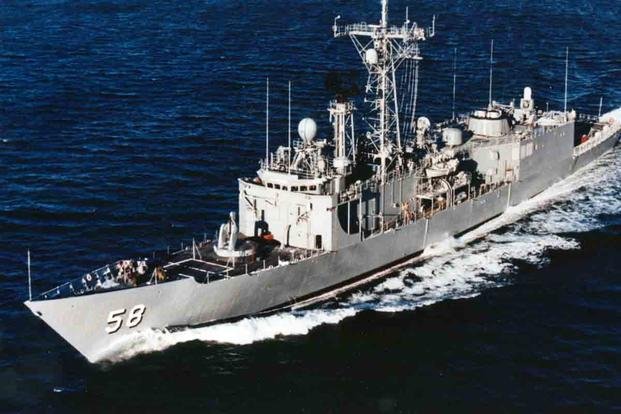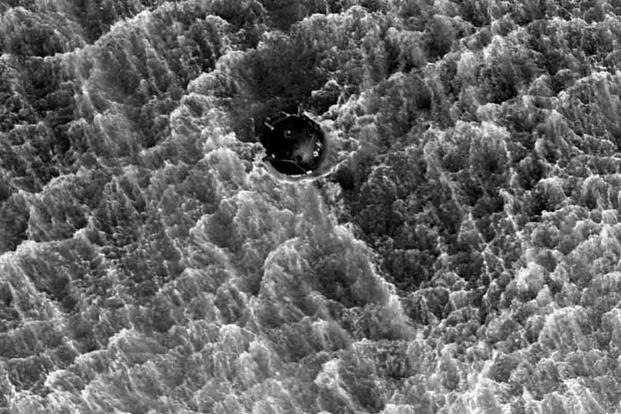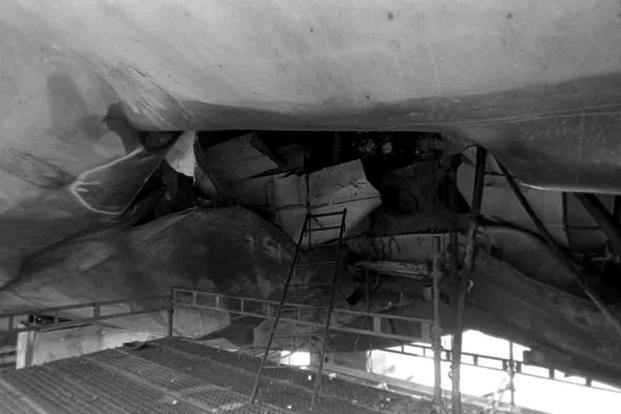Cmdr. Paul X. Rinn was in command of the guided missile frigate USS Samuel B. Roberts as it sailed into the Persian Gulf in 1988. His vessel's mission was to join Operation Earnest Will, the largest naval convoy since World War II, escorting Kuwaiti oil tankers and protecting them from Iranian attacks.
As the Roberts moved to resupply on April 14 of that year, it struck a mine that blew a 20-foot hole in its hull and started a massive fire aboard the ship. Rinn's frigate was suddenly faced with two problems, each equally fatal to the vessel and the more than 200 sailors and aviators aboard.
Operation Earnest Will was the U.S. Navy's response to the "tanker war" phase of the Iran-Iraq War. When Iran captured Iraq's al-Faw Peninsula in 1986, it left the country landlocked, and Iraq was forced to use Kuwaiti oil tankers and facilities to export its oil. Iran began attacking these vessels, then any tanker in the region.
Soon, both sides were attacking all merchant ships to cut off the other side's trade. The U.S. had discovered Iran's use of naval mines in 1987, when a Kuwaiti oil tanker flying the American flag hit a mine 20 miles off the coast of a small Iranian island. The U.S. deployed a large minesweeping force to the region, but finding all the mines proved difficult.
The Roberts was one of around 30 American warships deployed to protect shipping in the Persian Gulf during the operation. When it first arrived in the area, 67% of its crew had never been to sea, while another 20% had deployed on only one previous tour.

On April 14, 1988, Rinn and his ship were on their 14th convoy, escorting minesweepers out of Kuwait. While headed for a resupply with the USNS San Jose, Rinn received reports of naval mines just 350 yards away from the Roberts. He called the crew to general quarters, but ordered them to stay on the upper decks as a precaution. Then, he began to reverse the ship.
About 25 minutes into their attempt to escape from the minefield, one of the mines struck the ship. Rinn was standing 140 feet from the explosion, which he called "the loudest of my naval career."
The blast lifted the ship into the air and brought it splashing back down in a 100-foot fireball. Rinn's foot was broken, while seven sailors suffered burns and 57 more were injured.
As for the ship, its keel was shattered and its engine room destroyed. The entire vessel lost power, and its firemain (which pumps seawater into its firefighting systems) and diesel engines were damaged. A massive fire had engulfed the ship, while water poured into the hole in the hull. In just 90 seconds, the Roberts had taken on nearly half its total displacement in water and was held together only by the main deck.
With both the fire and the incoming water posing potentially fatal threats to the ship, Rinn was forced to make a tough call: which to deal with first.

After determining how much water the ship could take on and still stay afloat, he realized the ship would sink before his crew could put out the fire. To make matters worse, the water from the fire hoses was adding to the problem. They were helping to sink themselves.
He ordered the crew to stop fighting the fire and focus on the flooding. He knew they had to stay afloat or fighting the fire would be pointless.
While en route to the gulf and during the 13 escort missions it conducted before hitting the mine, Rinn had implemented a rigorous training and cross-training regimen for his crew. They were drilled for any situation, and everyone from cooks to radiomen learned to deal with any ship's two worst enemies: fire and flooding.
"Those are the guys that saved the ship," Rinn would later say during his post-retirement speaking tours.
He told his crew that if they didn't save one of the generators in the auxiliary machinery rooms, they would lose the ship. The Roberts had four electrical generators, three of which were flooded or in danger of being shut down. The last one, in auxiliary machinery room one, had been shut down for repairs before the incident.
Then, the lights started to flicker as the last operating diesel engine began to shut down. "If those lights go out, game over," Rinn thought to himself as he watched them flicker. He didn't have to worry for very long. Soon, the lights on the ship began to beam.

Engineman Fireman Mike Tilley and some of his shipmates had decided to stay below, close to one of the diesel generators, when the order to stay above decks was given. He was in auxiliary machinery room one when the mine exploded. When the lights went out, he and his fellow firemen decided to "suicide start" the generator, using high-pressure air to start a fan motor, which will start the main generator. There was just one flask of air left, so he had only one shot at it. After some initial issues, the generator came to life, saving the Samuel B. Roberts.
The ship was still sinking and burning in a minefield, but the working generator brought the firemain and dewatering systems back online. After restoring power, it wasn't long before the fire and flooding could be contained.
For four hours, the Roberts' crew fought for survival but won. They would eventually be towed back to port for repairs, and the ship would serve in the Navy for another 27 years.
-- Blake Stilwell can be reached at blake.stilwell@military.com. He can also be found on Twitter @blakestilwell or on Facebook.
Want to Learn More About Military Life?
Whether you're thinking of joining the military, looking for post-military careers or keeping up with military life and benefits, Military.com has you covered. Subscribe to Military.com to have military news, updates and resources delivered directly to your inbox.















